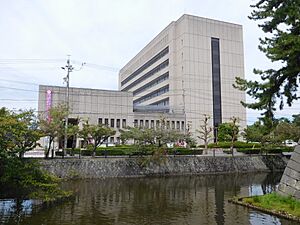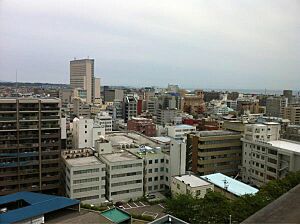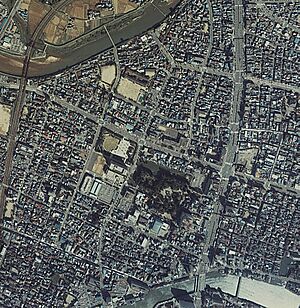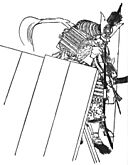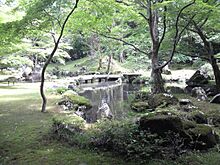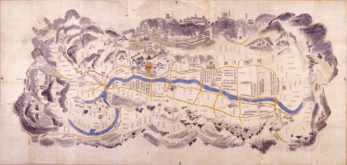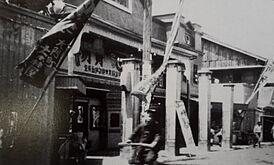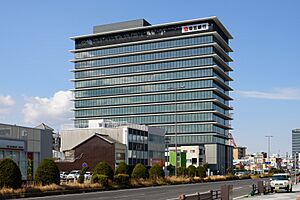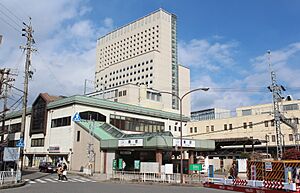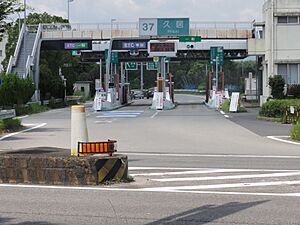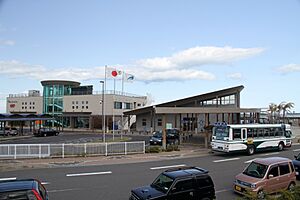Tsu, Mie facts for kids
Quick facts for kids
Tsu
津市
|
|||||||
|---|---|---|---|---|---|---|---|
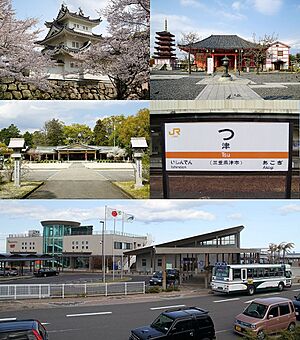
|
|||||||
|
|||||||
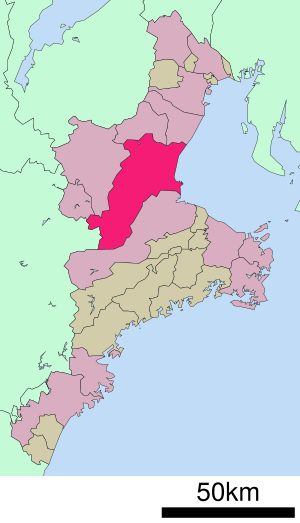 |
|||||||
| Country | Japan | ||||||
| Region | Kansai (Tōkai) | ||||||
| Prefecture | Mie | ||||||
| Area | |||||||
| • Total | 711.11 km2 (274.56 sq mi) | ||||||
| Population
(August 2021)
|
|||||||
| • Total | 274,879 | ||||||
| • Density | 386.549/km2 (1,001.158/sq mi) | ||||||
| Time zone | UTC+9 (Japan Standard Time) | ||||||
| Symbols | |||||||
| • Tree | Zelkova serrata | ||||||
| • Flower | Azalea | ||||||
| • Bird | Japanese bush warbler | ||||||
| Phone number | 059-229-3110 | ||||||
| Address | 23-1 Nishi-Marunouchi, Tsu-shi, Mie-ken 514-8611 | ||||||
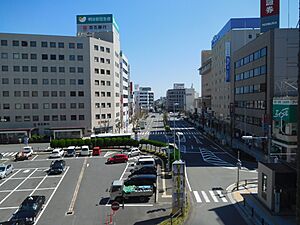
Tsu (津市, Tsu-shi) is the capital city of Mie Prefecture, Japan. As of July 31, 2021, about 274,879 people lived in Tsu. They lived in 127,273 homes. The city's total area is about 711.11 square kilometers. Tsu is the second largest city in Mie Prefecture by population. It is the main administrative and education center. This is because many government offices and schools are located here.
Contents
Exploring Tsu's Geography
Tsu is located in the east-central part of the Kii Peninsula. It is in the middle of Mie Prefecture. Tsu is the largest city in Mie Prefecture by land area. It stretches across the entire width of the prefecture. To the east, Tsu borders Ise Bay and the Pacific Ocean. To the west, it borders Nara Prefecture. Some parts of the city are inside the Murō-Akame-Aoyama Quasi-National Park. This is a special protected nature area.
Cities and Villages Near Tsu
Tsu has several cities and villages close by. They are:
- The city of Iga to the west.
- The city of Kameyama to the north.
- The city of Matsusaka to the south.
- The city of Nabari to the west.
- The village of Mitsue, Nara to the west.
- The village of Soni, Nara to the west.
- The city of Suzuka to the north.
Understanding Tsu's Climate
Tsu has a humid subtropical climate. This means it has warm summers and cool winters. There is usually little to no snowfall. The average temperature in Tsu each year is about 15.6 degrees Celsius. The city gets about 1931 millimeters of rain per year. September is usually the wettest month. Temperatures are highest in August, around 26.7 degrees Celsius. They are lowest in January, around 5.0 degrees Celsius. It rains a lot throughout the year. The heaviest rains are from May to September.
| Climate data for Tsu (1991−2020 normals, extremes 1889−present) | |||||||||||||
|---|---|---|---|---|---|---|---|---|---|---|---|---|---|
| Month | Jan | Feb | Mar | Apr | May | Jun | Jul | Aug | Sep | Oct | Nov | Dec | Year |
| Record high °C (°F) | 19.0 (66.2) |
22.8 (73.0) |
25.9 (78.6) |
31.0 (87.8) |
33.9 (93.0) |
36.7 (98.1) |
39.1 (102.4) |
39.5 (103.1) |
37.7 (99.9) |
31.0 (87.8) |
27.2 (81.0) |
23.7 (74.7) |
39.5 (103.1) |
| Mean daily maximum °C (°F) | 9.5 (49.1) |
10.0 (50.0) |
13.4 (56.1) |
18.6 (65.5) |
23.1 (73.6) |
26.2 (79.2) |
30.4 (86.7) |
31.6 (88.9) |
28.0 (82.4) |
22.6 (72.7) |
17.1 (62.8) |
12.0 (53.6) |
20.2 (68.4) |
| Daily mean °C (°F) | 5.7 (42.3) |
5.9 (42.6) |
9.0 (48.2) |
14.2 (57.6) |
19.0 (66.2) |
22.7 (72.9) |
26.8 (80.2) |
27.9 (82.2) |
24.4 (75.9) |
18.8 (65.8) |
13.2 (55.8) |
8.1 (46.6) |
16.3 (61.3) |
| Mean daily minimum °C (°F) | 2.4 (36.3) |
2.4 (36.3) |
5.2 (41.4) |
10.2 (50.4) |
15.4 (59.7) |
19.7 (67.5) |
24.0 (75.2) |
25.0 (77.0) |
21.4 (70.5) |
15.5 (59.9) |
9.5 (49.1) |
4.6 (40.3) |
12.9 (55.2) |
| Record low °C (°F) | −7.8 (18.0) |
−7.0 (19.4) |
−5.6 (21.9) |
−3.0 (26.6) |
3.0 (37.4) |
9.0 (48.2) |
14.6 (58.3) |
14.6 (58.3) |
8.7 (47.7) |
2.3 (36.1) |
−1.4 (29.5) |
−6.4 (20.5) |
−7.8 (18.0) |
| Average precipitation mm (inches) | 48.5 (1.91) |
57.1 (2.25) |
104.5 (4.11) |
129.0 (5.08) |
167.3 (6.59) |
201.8 (7.94) |
173.9 (6.85) |
144.5 (5.69) |
276.6 (10.89) |
186.1 (7.33) |
76.4 (3.01) |
47.2 (1.86) |
1,612.9 (63.50) |
| Average snowfall cm (inches) | 2 (0.8) |
3 (1.2) |
0 (0) |
0 (0) |
0 (0) |
0 (0) |
0 (0) |
0 (0) |
0 (0) |
0 (0) |
0 (0) |
1 (0.4) |
6 (2.4) |
| Average precipitation days (≥ 0.5 mm) | 6.4 | 7.5 | 10.5 | 9.8 | 10.9 | 12.8 | 12.3 | 9.8 | 12.3 | 10.1 | 6.8 | 6.5 | 115.7 |
| Average relative humidity (%) | 61 | 61 | 62 | 64 | 68 | 74 | 75 | 73 | 72 | 69 | 65 | 63 | 67 |
| Mean monthly sunshine hours | 162.9 | 156.2 | 186.1 | 192.7 | 197.8 | 146.9 | 180.2 | 220.7 | 165.3 | 164.5 | 163.7 | 171.5 | 2,108.6 |
| Source: Japan Meteorological Agency | |||||||||||||
Tsu's Population Over Time
The number of people living in Tsu has stayed pretty much the same over the last 40 years. This information comes from Japanese census data.
| Historical population | ||
|---|---|---|
| Year | Pop. | ±% |
| 1960 | 226,065 | — |
| 1970 | 242,000 | +7.0% |
| 1980 | 265,443 | +9.7% |
| 1990 | 280,384 | +5.6% |
| 2000 | 286,521 | +2.2% |
| 2010 | 285,728 | −0.3% |
A Look at Tsu's History
How Tsu Began
Tsu started as a port town. It was known as Anotsu (安濃津) during the Nara period and Heian periods. A port is a place where ships can load and unload goods.
In 1498, a big tsunami (a giant ocean wave) hit the area. This tsunami destroyed the port.
Tsu in the Edo Period
The town was rebuilt after the tsunami. It became a castle town. This means it grew around a castle. It also became a post station. Post stations were important stops for travelers. The Tōdō clan rebuilt the town. They were powerful lords called daimyō under the Tokugawa shogunate.
During the Edo period, many people stopped in Tsu. They were traveling to the famous Ise Grand Shrine. This shrine was about 40 kilometers away.
Tsu in Modern Times
After the Meiji Restoration, Tsu became the capital of Mie Prefecture in 1871. On April 1, 1889, Tsu was officially named one of Japan's first 31 cities. Over time, Tsu grew bigger. It took in nearby villages like Tatebe and Tosa in 1909. More villages joined in the 1930s and 1940s.
During World War II, Tsu faced challenges. Allied air raids in July 1945 destroyed most of the city. About 1,239 people lost their lives. After the war, Tsu continued to grow. It annexed more villages in the 1950s and 1970s.
On January 1, 2006, Tsu became even larger. It merged with several nearby cities, towns, and villages. These included Hisai, Anō, Geinō, Kawage, Misato, Hakusan, Ichishi, Karasu, and Misugi. This merger made Tsu the second largest city in Mie by population. It also became the largest city in Mie by land area.
Tsu's Economy
Tsu is home to some interesting companies. Imuraya Confectionery is a company that makes sweets. ZTV is a company that provides cable television services. Both of these companies have their main offices in Tsu.
Learning in Tsu: Education
Colleges and Universities
Tsu has several places for higher education. These include:
- Mie Prefectural College of Nursing
- Mie University, which is the only national university in the prefecture.
- Takada Junior College
- Tsu City College
Schools for Younger Students
The city government runs many schools for younger students. Tsu has 48 public elementary schools. It also has 19 public middle schools. Mie University has one public elementary school and one public middle school. There are also two private middle schools.
The Mie Prefectural Board of Education operates nine public high schools. Tsu also has three private high schools. For students with special needs, the prefecture runs six special education schools.
Getting Around Tsu: Transportation
Tsu has many ways to travel. You can get around by train, highway, or even by sea.
Railway Lines in Tsu
Several train lines serve Tsu.
 JR Tōkai – Kisei Main Line: Ishinden - Tsu - Akogi - Takachaya
JR Tōkai – Kisei Main Line: Ishinden - Tsu - Akogi - Takachaya JR Tōkai –Meishō Line: Ise-Hata - Ichishi - Isegi - Ise-Ōi – Ise-Kawaguchi - Sekinomiya - Ieki - Ise-Takehara - Ise-Kamakura - Ise-Yachi - Hitsu - Ise-Okitsu
JR Tōkai –Meishō Line: Ise-Hata - Ichishi - Isegi - Ise-Ōi – Ise-Kawaguchi - Sekinomiya - Ieki - Ise-Takehara - Ise-Kamakura - Ise-Yachi - Hitsu - Ise-Okitsu Kintetsu Railway -Nagoya Line: Chisato - Toyotsu-Ueno - Shiratsuka - Takadahonzan - Edobashi - Tsu - Tsu-shimmachi - Minamigaoka - Hisai - Momozono
Kintetsu Railway -Nagoya Line: Chisato - Toyotsu-Ueno - Shiratsuka - Takadahonzan - Edobashi - Tsu - Tsu-shimmachi - Minamigaoka - Hisai - Momozono Kintetsu Railway -Osaka Line: Higashi-Aoyama - Sakakibara-Onsenguchi - Ōmitsu - Ise-Ishibashi - Kawai-Takaoka
Kintetsu Railway -Osaka Line: Higashi-Aoyama - Sakakibara-Onsenguchi - Ōmitsu - Ise-Ishibashi - Kawai-Takaoka- Ise Railway - Ise Railway Ise Line: Ise-Ueno – Kawage – Higashi-Ishinden - Tsu
Major Highways
Tsu is connected by important roads.
Expressways
 Ise Expressway
Ise Expressway
National Routes
 National Route 23
National Route 23 National Route 163
National Route 163 National Route 165
National Route 165 National Route 306
National Route 306 National Route 368
National Route 368 National Route 369
National Route 369 National Route 422
National Route 422
Sea Ports
- Port of Tsu-Matsusaka
Tsu's Sister Cities
Tsu has special connections with other cities around the world. These are called sister cities.
 Higashishirakawa, Gifu, Japan (since June 28, 1989)
Higashishirakawa, Gifu, Japan (since June 28, 1989) Osasco, São Paulo, Brazil (since October 18, 1976)
Osasco, São Paulo, Brazil (since October 18, 1976) Zhenjiang, Jiangsu, China (since June 11, 1984)
Zhenjiang, Jiangsu, China (since June 11, 1984)
Fun Things to See and Do in Tsu
Tsu is known for its Tōjin Odori (唐人踊り) festival. This festival celebrates the arrival of a special group from Korea long ago. They were called the Joseon Tongsinsa delegation. Two other cities also celebrate Tōjin Odori. They are Suzuka city in Mie Prefecture and Ushimado-chō in Okayama Prefecture.
The old Tsu Castle is now a city park. You can visit the castle ruins downtown. Kitabatake Shrine and Yūki Shrine are important local Shinto shrines. They are places of worship.
Tsu's Culture and Sports
Sports Teams in Tsu
Tsu has a few sports teams.
Baseball
- Mie Takatora baseball club (JABA)
Volleyball
- Veertien Mie (V.League)
Famous People from Tsu
Many notable people come from Tsu.
- Sho Gokyu, a professional soccer player.
- Yuki Hashimoto, a politician and former idol.
- Mu Kanazaki, a professional soccer player.
- Kintaro Kanemura, a professional wrestler.
- Kōji Kitao, a sumo wrestler.
- Kotokaze Kōki, a sumo wrestler.
- Yoshihito Nishioka, a professional tennis player.
- Ayumi Oka, an actress.
- Hiroshi Okuda, former president of Toyota Motors.
- Keisuke Okuda, a professional wrestler.
- Edogawa Rampo, a famous author.
- Chikara Sakaguchi, a politician.
- Kōdō Sawaki, a Zen Buddhist teacher.
- Hidesaburō Ueno, an agricultural scientist.
- Saori Yoshida, an Olympic wrestler.
See also
 In Spanish: Tsu (Mie) para niños
In Spanish: Tsu (Mie) para niños





